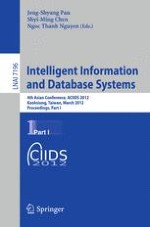The three-volume set LNAI 7196, LNAI 7197 and LNAI 7198 constitutes the refereed proceedings of the 4th Asian Conference on Intelligent Information and Database Systems, ACIIDS 2012, held in Kaohsiung, Taiwan in March 2012.
The 161 revised papers presented were carefully reviewed and selected from more than 472 submissions. The papers included cover the following topics: intelligent database systems, data warehouses and data mining, natural language processing and computational linguistics, semantic Web, social networks and recommendation systems, collaborative systems and applications, e-bussiness and e-commerce systems, e-learning systems, information modeling and requirements engineering, information retrieval systems, intelligent agents and multi-agent systems, intelligent information systems, intelligent internet systems, intelligent optimization techniques, object-relational DBMS, ontologies and knowledge sharing, semi-structured and XML database systems, unified modeling language and unified processes, Web services and semantic Web, computer networks and communication systems.
